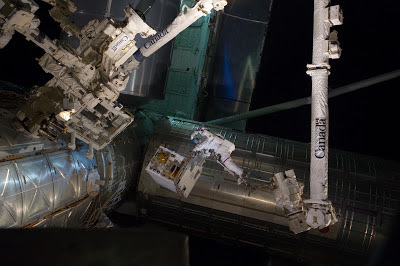Wouldn't that be an awesome name for a punk band?? Some of you may remember Fast Eddie from my article in 2010 about his awesome work with spacesuit glove testing and Hubble mania! Ed has held some amazing positions with NASA over many moons, but may have one of the most important jobs of his career now, in terms of Earth's technological future.
Me & Ed with ROSIE
See that big block behind our heads in the Satellite Servicing Capabilities Office (SSCO) at NASA Goddard? THAT is the star of the Robotic Refueling Mission (RRM) now being tested on orbit by the space station crew and robots.
Humorously named after the cartoon Jetsons robot, the block is ROSIE, or the Robotic Operating Simulator for Integration and Evaluation. She and all her delightful tools and gizmos were the very last American Space Shuttle payload by Atlantis STS-135 in July 2011. ROSIE was installed into the ELC-4, with the intent for Dextre to demonstrate refueling experiments throughout 2012 and 2013.
Astronaut Ron Garan delivering ROSIE to the ISS
for joint experiments between NASA & CSA
for joint experiments between NASA & CSA
This is one of the those NASA Projects where I do the research, learn about the work, meet the people involved, and then realize certain things at NASA truly do need budget doubling.
An incredible amount of things in our modern lives depend on satellites. (But I wonder how many people appreciate them until their smartphone or TV aren't working?!) Drawing upon 20 years of experience servicing the Hubble, the SSCO initiated the development of RRM to demonstrate the feasibility and practicality of robotically refueling and servicing satellites on-orbit. Exploring ways to do this without "catching" them or simply adding to the dead, floating space debris junkyard, is worth our time, trouble and future investments!
Artistic representation of Dextre
performing a robotic refueling task on RRM
performing a robotic refueling task on RRM
Someday, it will allow NASA and commercial entities to launch larger and more complex satellites, because they can travel without heavy fuel, then meet with a separate fuel source in orbit, much the same way a car pulls off the highway when it needs a gasoline station.
Dextre will work on ROSIE's multiple activity boards,check-listing through tests on protective thermal blankets, caps, valves, simulated fuel, and other components that need to be pushed back, cut through, unscrewed and transferred. Each component and activity board represents and individual refueling or servicing task, and each RRM is designed to efficiently complete a wide range of targeted activities.
Ed removing the Wire Cutter Tool from
one of the RRM Activity Boards
one of the RRM Activity Boards
Wire sheaths? Nozzles? No problem. Robots got this. The tool collections primary functions are to cut and manipulate wires, unscrew caps, open and close valves and transfer fluid. Tools also have integral cameras for ground operator vision and include specialized features tailored to complete each task.
Technology and techniques are all being verified on orbit as we speak, and you can follow the action at the Satellite Servicing Office's Facebook page.
SSCO Office and Weightless Testing "Sky"
Curious how refueling a satellite in space can impact your day-to-day activities on Earth? Check this awesome ROBOTIC REFUELING video by CTV, who crammed a stunning amount of awesome information and NASA coolness into 3 minutes.
To see the entire gallery of pictures from Ed's tour of the Satellite Servicing Capabilities Office at NASA Goddard Space Flight Center in Greenbelt, Maryland, click this link or any of the pictures above. Thanks for your time, Fast Eddie!









